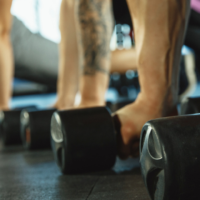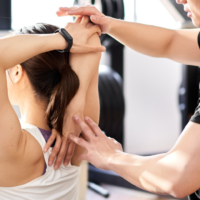How to Manage Pain
The stress of the current circumstances of the world, lack of normal routines for activity and sport, and for some, the impact of poor ergonomic working situations have led many of us to experience increased body aches and pains. Registered Physiotherapist, Daniel Lahav, from our Mayfair Lakeshore Sports Clinic believes that pain is your body’s alarm system and explains his recommendations for when you should seek treatment from an expert. Read on to learn more.
What is the Definition of Pain?
Pain is – an unpleasant sensory and emotional experience associated with actual or potential tissue damage or described in terms of such damage (by the International Association of the Study of Pain). Pain is the body’s way of telling you something is not right. It is an alarm system. The sensation of pain is meant to make you respond by modifying your behaviour or seeking help.
Three Types of Exercise Pain
There are three types of pain patients can experience while exercising (these are rules of thumb, not mathematical equations):
Sharp Pain
- If you have sharp pain while engaged in an exercise or activity, I recommend that you stop what you are doing and don’t do it again. Seek advice or help as to why this is happening.
Low-Grade Soreness
- If you experience some soreness while engaged in an activity or exercise – try to modify the activity to make it easier (lowering the weight or reps, or by adding supports to the exercise, etc.) If your pain is increasing even after you have made your modifications – stop the exercise and consider seeking help or advice by an expert.
Decreasing Pain
- If your pain appears to decrease as you continue with your activity or exercise – keep going. You should be ok. However, if the pain is an ongoing occurrence for you – you should seek expert help. It ok to feel muscle soreness following an exercise session, but not ok to feel joint pain or any other pain on a regular basis.
How Your Body Communicates Pain
Everyone experiences body aches and pain at some point in their lives. Sometimes it can be due to an event (like a car accident or a serious fall). Other times it can be due to a behavioural habit (faulty posture or movement habits like ongoing slouching in sitting or running with ‘knock knees’).
Pain is very subjective. There is no pain centre in the brain and every individual experiences pain in his or her own unique way. There is no correlation between how much wear and tear there is in anyone’s body and how much pain someone is suffering from. There are people that show on diagnostic tests (x-ray, ultrasound, or MRI etc.) significant wear and tear yet aren’t complaining of any pain or suffering from very mild pain and others who show mild wear and tear results on their diagnostic yet are suffering from immense pain.
In Orthopaedics, the only time you can correlate the amount of pain to tissue damage is when there is a traumatic event like a car accident, a fall, or being hit, etc).
Reasons to Seek Treatment
There are two main reasons why you should seek help when you don’t understand why you are hurting:
First, when pain is more acute (or new, meaning its a new pain up to 3 months), it tends to be better correlated to tissue damage compared to people who suffer from chronic pain (ongoing pain more than 6 months) where that correlation is lost, making it harder to diagnose and treat the chronic pain population.
Secondly, regardless of your attitude to pain (whether it freaks you out, or you just push it to the recesses of your consciousness), the part in your brain that is in charge of movement (in your subconscious brain) always (whether you like it or not) responds to pain and will choose a compensatory strategy to avoid pain.
“Pain is not your enemy. It is an alarm system that you should always listen and respond to.”
Get a Hypothesis
It is important to understand that the location of pain is not always the cause of your pain. Your knee can hurt because there is a dysfunctional movement habit in your hip. Your neck can hurt because your mid back is too stiff and not contributing its share of movement, causing the neck to move too much which results in neck pain. If this makes sense to you, then you shouldn’t be satisfied with a diagnosis like discogenic pain in your low back or osteoarthritis in your neck. Your Practitioner should give you a hypothesis on why you developed a discogenic pain in your low back or why your neck is arthritic.
Pain can be in one area of your body, but its cause or drive could be somewhere else.
Whenever you seek treatment – your goal should always be to leave with an informed hypothesis as to the posture, movement or activity you’re doing that is causing you to feel pain (unless there is a clear story of an event like a accident or fall). This hypothesis which seeks to explain how you got your pain will translate into a better overall treatment plan that will help to reduce the pain.
Our Sports Clinics Are Open
Don’t wait to seek treatment for your pain. The sooner you deal with it by speaking to a Professional, the sooner you will start feeling better. Visit our website to learn more about our Wellness Professionals and the Services we are currently offering.
About The Author
Dr. Daniel Lahav, is a Registered Physiotherapist from our Mayfair Lakeshore Sports Clinic location.

Mayfair Clubs
Mayfair Clubs (www.mayfairclubs.com) is a modern sports club with four locations in Toronto, Canada.
Newsletter
Sign up
Join our Mayfair Newsletter for the latest member news, events, contests, promotions and blogs. You may unsubscribe at anytime by clicking the "unsubscribe" link at the bottom of all newsletter emails.
 Lakeshore (416) 466-3777
801 Lake Shore Blvd E Toronto, ON Lakeshore and DVPs
Lakeshore (416) 466-3777
801 Lake Shore Blvd E Toronto, ON Lakeshore and DVPs
 West (416) 638-1010
3855 Chesswood Dr Toronto, ON Sheppard and Dufferin
West (416) 638-1010
3855 Chesswood Dr Toronto, ON Sheppard and Dufferin
 Parkway (905) 475-0350
50 Steelcase Rd. E. Toronto, ON Woodbine and Steeles
Parkway (905) 475-0350
50 Steelcase Rd. E. Toronto, ON Woodbine and Steeles
 East (905) 475-8833
160 Esna Park Dr Markham, ON Denison and Victoria Park
East (905) 475-8833
160 Esna Park Dr Markham, ON Denison and Victoria Park






































